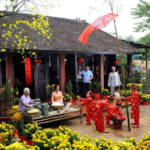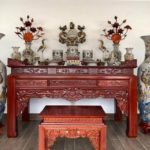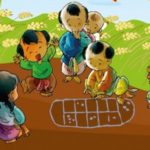Tet Holiday is one of the most anticipated times of the year in Vietnamese culture. It is the longest holiday period, providing an opportunity for family members living away from home to return and reunite with their parents and spouses. This may explain why almost every family, regardless of their financial situation, strives to prepare a sumptuous feast for Tet, especially the ancestral offering feast.
However, not everyone knows exactly what dishes to prepare for a complete and fulfilling Tet feast. Let’s explore this topic further in the following article!
1 Significance of the First Day of Tet

There is a popular saying in Vietnam, ” Mùng 1 Tết cha, mùng 2 Tết mẹ, mùng 3 Tết thầy,” which translates to “The first day of Tet is for honoring fathers, the second day is for mothers, and the third day is for teachers.” This saying forms the basis for the significance of the first day of Tet. According to traditional Vietnamese beliefs, the father holds the highest position in the family and is considered the family’s pillar.
The proverb, “A fatherless child is like a house without a roof,” emphasizes the crucial role of the father in the family. He is likened to the “roof” – the highest position, providing shelter and protection for the family. Fathers dedicate their lives to safeguarding and supporting their loved ones, serving as the sturdy pillar of the household.

Thus, the first day of Tet is dedicated to fathers, offering an opportunity for children to express their gratitude and respect to their fathers.
2 Significance of the First Day of Tet Offerings
As a significant occasion and a time for family reunion after a year of hard work and study, the Tet feast is carefully prepared with an abundance of dishes, each meticulously crafted. With wishes for a prosperous, happy, and fulfilling year ahead, families take great care in arranging a diverse and well-presented offering feast.

Moreover, the offering feast also expresses gratitude to ancestors, grandparents, and those who have contributed to the country’s peace and well-being. Therefore, from the night of the 30th to the end of the third day of Tet, families meticulously prepare and present their offering feasts with reverence.
3 The First Day of Tet Offering Feast
According to the book “Tín ngưỡng Việt Nam” (Vietnamese Beliefs) by author Luu Anh, published by Tre Publishing House, the offering feast for the first day of Tet typically includes incense, flowers, paper money, candles, betel and areca nuts, wine, and bánh chưng (square sticky rice cake) or bánh tét (cylindrical sticky rice cake). Both vegetarian and non-vegetarian dishes are acceptable, but they must be prepared meticulously and presented with solemnity and elegance.

Nowadays, there is less emphasis on the variety of dishes, and a simpler feast of 4-5 dishes that suit the family’s economic situation is common. What matters most is the sincerity of the offering and the joy of gathering together during Tet.
Let’s take a look at some familiar and simple ways to arrange the offering feast:
Northern-Style Offering Feast
The Northern-style offering feast typically includes four bowls and four plates, symbolizing the four pillars, four seasons, and four directions. More elaborate families may present six or even eight bowls and plates.

The four plates usually consist of boiled chicken, pork, giò lụa (Vietnamese pork sausage), and chả quế (cinnamon pork sausage). Additionally, there is always a plate of xôi gấc (sticky rice with gac fruit), symbolizing good luck and the vibrant red color of the gac fruit in the new year.
The four bowls typically include stewed pig’s trotters with bamboo shoots, bóng thả (a type of processed pork product), dưa món (pickled vegetables), and mọc nấm thả (a type of meatball soup). The bánh chưng must be made with a combination of lean and fatty pork, with a square piece of pork belly in the center, scored and opened into four corners.
In the North, it is customary to avoid killing animals during the new year, so most dishes in the offering feast are prepared in advance.
Central-Style Offering Feast
The Central-style offering feast tends to be more diverse, featuring a wider range of dry and wet dishes compared to the Southern style. It usually includes flavorful and spicy dishes such as nem lụi (grilled pork skewers), bò nướng sả ớt (grilled beef with lemongrass and chili), roasted pig, roasted chicken, bò nấu thưng (beef stew), braised pork belly and turnips, and braised lean pork.

Additionally, there are pickled onions and a specialty of Central Vietnam, various types of rolls, such as fresh spring rolls and rice paper rolls with herbs. The meal often concludes with colorful and artistic desserts like bánh ngũ sắc (five-color cake), bánh phục linh (a type of glutinous rice cake), bánh sen tán (lotus seed cake), and bánh in bột nếp (glutinous rice flour cake).
Southern-Style Offering Feast
The Southern-style offering feast is generally simpler and depends on the family’s economic situation. It reflects the region’s fertility and abundance, without the complexity often associated with the Northern-style feast.
The Southern-style feast offers a diverse menu and is not bound by strict rules. Common dishes include fried spring rolls, fresh herbs, pickled vegetables, chicken salad, and kiệu (pickled leeks). Bánh tét is a must-have item, and it comes in various forms, such as purple sticky rice cakes, sweet sticky rice cakes, or coconut sticky rice cakes, with fillings like meat or duck eggs.
 Southern-Style Offering Feast
Southern-Style Offering Feast
Two dishes that are often present in the Southern-style feast are củ kiệu (pickled leeks) and dưa hành (pickled onions), symbolizing hopes for a prosperous and happy new year.
Vegetarian Offering Feast
Some families following Buddhist teachings believe that the first day of the new year should be meat-free. Instead of preparing a non-vegetarian offering feast, they opt for a vegetarian one. Here are some typical dishes:
- Stir-fried vegetables: Carrots, young corn, mushrooms, napa cabbage, and other vegetables of your choice.
- Tofu: A staple in vegetarian cuisine, tofu can be prepared in various ways, such as fried tofu, tofu with tomato sauce, or tofu and mushroom stir-fry.
 Vegetarian Offering Feast
Vegetarian Offering Feast
- Soup: Whether it’s a vegetarian or non-vegetarian feast, a bowl of soup is always included. Simply choose your favorite mushrooms, vegetables, or other ingredients without any complicated preparation.
- Xôi (Sticky Rice): Xôi is a common dish in both vegetarian and non-vegetarian offering feasts. It can be made with mung beans, coconut, or pandan leaves, among other variations.
4 Incantation for the First Day of Tet
Incantation 1: Ancestral Worship on the First Day of Tet
(Excerpted from “Văn khấn cổ truyền Việt Nam” – Vietnamese Traditional Incantations, published by Van Hoa Thong Tin Publishing House)

Nam mô A Di Đà Phật (Recited and bowed three times)
We bow to the nine directions of the sky and the ten directions of the Buddhas.
We respectfully bow to the Future Buddha Maitreya.
We respectfully bow to our ancestors, including our great-grandparents, grandparents, uncles, aunts, and all our relatives.
Today is the first day of the first month of the year … We, …, currently residing at …, ward/precinct …, district/town …, province/city …, offer our sincere prayers.
Following the laws of the universe and the movement of yin and yang, we have reached the beginning of the new year, the first day of spring, a time when the rain and dew nourish all things, welcoming a new year.
We, the descendants, remember the grace of our ancestors, as vast as the sky and the ocean. We cannot repay their kindness with mere words.
Therefore, we, along with all the family members, have prepared offerings, fruits, incense, and flowers to present before the ancestral altar.
We respectfully invite our ancestors, including our great-grandparents, grandparents, uncles, aunts, and all our relatives, to graciously accept our offerings and descend upon this altar. We pray for your blessings and protection, for a peaceful and prosperous new year, free from any harm or misfortune, and filled with blessings and good omens.
We sincerely invite the spirits of the land and the previous and current owners of this land to join us in this ceremony and bestow their blessings upon us, granting us good fortune and success in all our endeavors.
Our offerings may be simple, but our hearts are sincere. We bow before the ancestral altar and pray for your blessings and protection.
Nam mô A-di-đà Phật (Recited and bowed three times)
Incantation 2: Worship of the Gods on the First Day of Tet

Nam mô A Di Đà Phật (Recited three times)
We bow to the nine directions of the sky and the ten directions of the Buddhas.
We respectfully bow to the Future Buddha Maitreya.
We respectfully bow to the Gods of Heaven and Earth.
We respectfully bow to all the deities.
Today is the first day of the first month, the Tet Nguyen Dan holiday, a time when the harsh and cold east wind dissipates, and all things are renewed with the arrival of spring.
We, the people, present our offerings of incense, flowers, fruits, and food to the Gods of Heaven and Earth.
We believe that the Gods’ aura is brilliant and their grace is immense. Their position is lofty, and their virtue is boundless. Our sincere prayers can reach them.
We invite the Gods to descend upon this altar and accept our humble offerings.
We pray for happiness and prosperity for all, and we ask for the blessings of the local gods and the deities of this land. May they grant us good health, fortune, and success in all our endeavors.
We offer our sincere prayers and invite the deities to witness and bestow their blessings upon us.
Nam mô A-di-đà Phật (Recited and bowed three times)
For reference: Giáp Thìn 2024 – The Most Comprehensive Guide
Incantation 3: Another Tet Incantation from the Book “Tập văn cúng gia tiên”
(Published by Van Hoa Dan Toc Publishing House)

Today is the … day …
The …






































